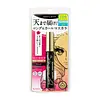Flower Knows Chocolate Wonder-Shop Mascara Versus ISEHAN Heroine Make Long Up Mascara Super Waterproof
What's inside
What's inside
 Key Ingredients
Key Ingredients

 Benefits
Benefits

 Concerns
Concerns

 Ingredients Side-by-side
Ingredients Side-by-side

Isododecane
EmollientTrimethylsiloxysilicate
EmollientCeresin
Emulsion StabilisingBeeswax
Emulsion StabilisingMicrocrystalline Wax
Emulsion StabilisingTalc
AbrasivePolypropylsilsesquioxane
CI 77499
Cosmetic ColorantDisteardimonium Hectorite
StabilisingDextrin Palmitate/Ethylhexanoate
EmulsifyingHydrogenated Polyisobutene
EmollientPropylene Carbonate
SolventCellulose
AbsorbentRayon
Phenoxyethanol
PreservativeTriethoxycaprylylsilane
Ethylhexylglycerin
Skin ConditioningCI 77266
Cosmetic ColorantSilica
AbrasiveBHT
AntioxidantTocopherol
AntioxidantIsododecane, Trimethylsiloxysilicate, Ceresin, Beeswax, Microcrystalline Wax, Talc, Polypropylsilsesquioxane, CI 77499, Disteardimonium Hectorite, Dextrin Palmitate/Ethylhexanoate, Hydrogenated Polyisobutene, Propylene Carbonate, Cellulose, Rayon, Phenoxyethanol, Triethoxycaprylylsilane, Ethylhexylglycerin, CI 77266, Silica, BHT, Tocopherol
Isododecane
EmollientTrimethylsiloxysilicate
EmollientTalc
AbrasiveMicrocrystalline Wax
Emulsion StabilisingCeresin
Emulsion StabilisingDisteardimonium Hectorite
StabilisingDextrin
AbsorbentHydrogenated Polyisobutene
EmollientPropylene Carbonate
SolventPrunus Amygdalus Dulcis Oil
Skin ConditioningCamellia Seed Oil
Argania Spinosa Kernel Oil
EmollientRosa Canina Fruit Oil
EmollientDaucus Carota Sativa Root Extract
Skin ConditioningRoyal Jelly Extract
Skin ConditioningNylon-66
Sucrose Tristearate
EmollientAluminum Distearate
Emulsion StabilisingGlyceryl Isostearate
EmollientTrimethylsiloxysilylcarbamoyl Pullulan
Polymethylsilsesquioxane
Lauric Acid
CleansingZinc
AntioxidantSilica
AbrasiveSqualane
EmollientAcrylates/Ethylhexyl Acrylate Copolymer
Hydroxyethyl Acrylate/Methoxyethyl Acrylate Copolymer
Dimethicone
EmollientAmmonium Acrylates Copolymer
Sodium Dehydroacetate
PreservativeTocopherol
AntioxidantDiethyl Ascorbic Acid
Skin ConditioningCI 77492
Cosmetic ColorantTitanium Dioxide
Cosmetic ColorantIsododecane, Trimethylsiloxysilicate, Talc, Microcrystalline Wax, Ceresin, Disteardimonium Hectorite, Dextrin, Hydrogenated Polyisobutene, Propylene Carbonate, Prunus Amygdalus Dulcis Oil, Camellia Seed Oil, Argania Spinosa Kernel Oil, Rosa Canina Fruit Oil, Daucus Carota Sativa Root Extract, Royal Jelly Extract, Nylon-66, Sucrose Tristearate, Aluminum Distearate, Glyceryl Isostearate, Trimethylsiloxysilylcarbamoyl Pullulan, Polymethylsilsesquioxane, Lauric Acid, Zinc, Silica, Squalane, Acrylates/Ethylhexyl Acrylate Copolymer, Hydroxyethyl Acrylate/Methoxyethyl Acrylate Copolymer, Dimethicone, Ammonium Acrylates Copolymer, Sodium Dehydroacetate, Tocopherol, Diethyl Ascorbic Acid, CI 77492, Titanium Dioxide
 Reviews
Reviews

Ingredients Explained
These ingredients are found in both products.
Ingredients higher up in an ingredient list are typically present in a larger amount.
Ceresin is a wax derived from ozokerite. It is an alternative to beeswax.
The most common process of creating ceresin is by using heat and sulfuric acid.
Disteardimonium Hectorite comes from the clay mineral named hectorite. It is used to add thickness to a product.
It can also help stabilize a product by helping to disperse other ingredients.
Hectorite is a rare, white clay mineral.
Learn more about Disteardimonium HectoriteHydrogenated Polyisobutene is a synthetic polymer. Polymers are compounds with high molecular weight. Hydrogenated Polyisobutene is an emollient and texture enhancer.
In one study, Hydrogenated Polyisobutene showed better skin hydration levels than Caprylic/Capric Triglyceride. As an emollient, it helps keep your skin soft and hydrated by trapping moisture in.
Hydrogenated Polyisobutene is often used as a mineral oil replacement.
Learn more about Hydrogenated PolyisobuteneIsododecane is a fragrance, emollient, and solvent.
As an emollient, it helps your skin stay soft and hydrated. Emollients help trap moisture into your skin.
Isododecane's role as a solvent makes it a great texture enhancer. It spreads smoothly on skin and does not leave a sticky feeling behind. Isododecane also helps prevent color transfer in makeup products.
Isododecane is not absorbed into skin.
Learn more about IsododecaneMicrocrystalline Wax is created by de-oiling petroleum. It is highly refined and purified before being added to cosmetics.
Microcrystalline Wax is used to enhance the texture and create even consistency. It helps stabilize a product by preventing ingredients from separating.
This ingredient is a solvent. It helps dissolve active ingredients and alter the texture of products.
Propylene Carbonate is commonly used in makeup and with clay, such as montmorillonite or bentonite.
Studies show this ingredient to be safe for cosmetics. When it is undiluted, it can cause skin irritation. (It is always diluted in skincare and makeup). This ingredient is water-soluble.
Propylene Carbonate is created from propylene glycol and carbonic acid.
Learn more about Propylene CarbonateSilica, also known as silicon dioxide, is a naturally occurring mineral. It is used as a fine, spherical, and porous powder in cosmetics.
Though it has exfoliant properties, the function of silica varies depending on the product.
The unique structure of silica enhances the spreadability and adds smoothness, making it a great texture enhancer.
It is also used as an active carrier, emulsifier, and mattifier due to its ability to absorb excess oil.
In some products, tiny microneedles called spicules are made from silica or hydrolyzed sponge. When you rub them in, they lightly polish away dead skin layers and enhance the penetration of active ingredients.
Learn more about SilicaTalc is a clay mineral. It helps absorb moisture and improve the texture of products. Like other types of clay, Talc can have a slight exfoliating effect on skin. Talc can be added to increase the volume of products.
Some Baby powders are made by combining talc with corn starch. The word "talc" comes from Latin and originates from Arabic. Talc is a mineral commonly found throughout the world.
If you have any concerns about using talc, we recommend checking out the FDA's official page.
Learn more about TalcTocopherol (also known as Vitamin E) is a common antioxidant used to help protect the skin from free-radicals and strengthen the skin barrier. It's also fat soluble - this means our skin is great at absorbing it.
Vitamin E also helps keep your natural skin lipids healthy. Your lipid skin barrier naturally consists of lipids, ceramides, and fatty acids. Vitamin E offers extra protection for your skin’s lipid barrier, keeping your skin healthy and nourished.
Another benefit is a bit of UV protection. Vitamin E helps reduce the damage caused by UVB rays. (It should not replace your sunscreen). Combining it with Vitamin C can decrease sunburned cells and hyperpigmentation after UV exposure.
You might have noticed Vitamin E + C often paired together. This is because it is great at stabilizing Vitamin C. Using the two together helps increase the effectiveness of both ingredients.
There are often claims that Vitamin E can reduce/prevent scarring, but these claims haven't been confirmed by scientific research.
Learn more about TocopherolThis silicone is an emollient. Emollients create a thin film on the skin to prevent moisture from escaping.
It is not soluble in water and helps increase water-resistance in products.
According to a manufacturer, it can blend seamlessly with silicone oils, such as Cyclopentasiloxane.
Learn more about Trimethylsiloxysilicate